Although hiring confidence has moderated slightly amid the global economic downturn, labor markets remain tight, and the challenge of retaining top talent persists for businesses worldwide.
Jonas Prising, ManpowerGroup Chairman and CEO, says:
"As companies continue to transform their business models, many are holding onto the talent they have and struggling to find the new talent they need.”
HR leaders are actively striving to provide differentiating and compelling employee experiences. Purposefully listening to employees across the employee lifecycle offers valuable insights for shaping experiences that attract, engage, and retain talent.
An employee listening survey serves as an excellent tool for creating a safe space for employees to voice their opinions. It also helps businesses to keep a steadier finger on the pulse of employee sentiment, identifying workforce management gaps and challenges promptly.
Here's a quick overview of what we'll cover in this article:
Table of contents
What is an employee listening survey?
Why do you need an employee listening survey?
Types of employee listening surveys
How often should you conduct employee listening surveys?
Employee listening strategy examples
Tips to make your employee listening survey strategy a success
What is an employee listening survey?
An employee listening survey is a tool to understand, validate, and improve employee experience. It enables employees to express their ideas and put forward suggestions, fostering a culture of transparency. Organizations employ listening surveys to uncover insights into workplace culture, communication, leadership, and overall job satisfaction.
“Of all the skills of leadership, listening is the most valuable — and one of the least understood. Most captains of industry listen only sometimes, and they remain ordinary leaders. But a few, the great ones, never stop listening. That's how they get word before anyone else of unseen problems and opportunities.”
— Peter Nulty, Fortune Magazine
Employee listening surveys gather regular input and feedback from employees. The questions in these surveys are designed to address current issues and changes in employee sentiment. This enables HR teams to understand employee needs more deeply and frequently.
Additionally, business leaders can also leverage the collected feedback to identify strengths, pinpoint improvement areas, and make data-driven decisions to improve the work environment.
Let’s move on to explore further benefits of an employee listening survey.
Why do you need an employee listening survey?
Employee listening surveys are the stethoscope that checks a company’s heartbeat. They help every employee feel valued, understood, and empowered. There are multifold benefits to implementing an employee listening survey, including the following:
1. Strengthen employee relationship
You can demonstrate empathy and concern for well-being by actively listening to your employees. Employee listening surveys create an environment where individuals openly share their ideas, problems, and feedback. This strengthens relationships between employees and management and cultivates a culture of trust and collaboration.
2. Build a motivated and productive workforce
“Employees who feel their voice is heard are 4.6 times more likely to feel empowered to perform their best work.”
When employees feel that their opinions about their jobs are valued and that they can influence how their company operates, it leads to greater job satisfaction, motivating them to perform at their best. Regular check-ins, pulse surveys, and employee lifecycle surveys help employees feel empowered to make decisions independently.
3. Retain top talent
Organizations with engaged employees see 59% less employee turnover. When employees feel genuinely heard and understood, they are more likely to feel valued and are more likely to remain loyal to their organization. In addition, an employee listening survey enables HR leaders to identify and address any issues they may be facing promptly. This proactive approach helps prevent potential conflicts and dissatisfaction. The result? Higher retention rates.
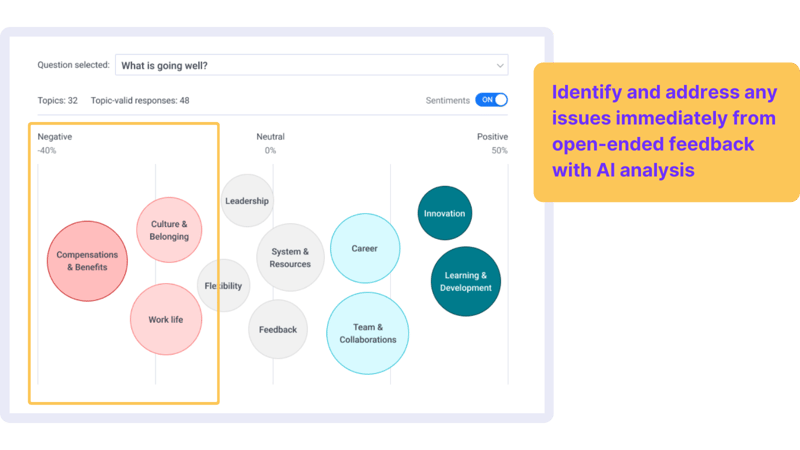
BELONG - an employee listening survey platform that enables HR leaders to identify and address any issues they may be facing promptly ©EngageRocket
4. Improve bottom line
Continuous listening fosters employee engagement. It creates an emotional connection, and engaged employees are more present and productive. They are more attuned to the needs of customers and more observant of processes, standards, and systems, which in turn helps to boost organizations' profitability.
5. Create a culture of open communication
Voice of employee surveys creates a platform for open communication. The anonymity allows employees to express their thoughts, concerns, and suggestions without fear of reprisal. This creates a culture of open communication and sets a positive tone for the organization.
Types of employee listening surveys
Crafting effective employee listening campaigns involves a blend of broader surveying approaches. Here are the surveys you should add to your employee listening toolkit.
 An illustrative example of a continuous employee listening strategy that leverages all 3 key types of surveys: annual engagement survey, pulse surveys, and lifecycle surveys.
An illustrative example of a continuous employee listening strategy that leverages all 3 key types of surveys: annual engagement survey, pulse surveys, and lifecycle surveys.
1. Annual employee engagement survey
Also called ‘census surveys’, these are comprehensive surveys typically conducted once a year. They aim to gauge the overall level of engagement and satisfaction among employees. A typical employee engagement survey covers various topics, from job satisfaction management effectiveness to workplace culture. The data gathered serves as a benchmark for year-over-year comparisons, helping organizations track their progress in improving the workplace experience.
2. Pulse survey
Pulse surveys are designed to collect employee feedback more quickly and efficiently than the annual engagement survey. These topical surveys could cover a general topic for the whole population or target specific facets of the employee experience for focused insights.
Additionally, these surveys are flexible; you can send them to specific segments, teams, or a random subset of employees, especially when you want to measure the success of an implemented change initiative. Here are four examples of pulse surveys:
A. Wellbeing survey
It evaluates employees' overall wellness and satisfaction with their work-life balance, mental and physical health, and stress levels.
B. DEI (diversity, equity, and inclusion) survey
A DEI survey is also called DEIB - diversity, equity, inclusion, and belongingness survey. It assesses how effectively your organization embraces diversity, fosters equity, and promotes inclusivity. The data gathered enables you to identify gaps in your DEI efforts. This can help you create strategies that foster a more inclusive work environment.
C. Benefits survey
It gauges the employees' opinions about your benefits program. These surveys assess the perceived value of these benefits and include various questions about benefits, perks, wellness programs, health coverage, and more.
D. Company values survey
These surveys provide valuable insights into employees' alignment with the organization's core values and culture.
3. Employee lifecycle surveys
Employee lifecycle surveys run continuously and will be triggered based on specific tenure milestones or events in the employee lifecycle. This helps you keep your listening flywheel up and running in various stages such as the first 30, 60, and 90 days of employment of a new hire or when the employee exits the organization.
A. Onboarding survey
What do your new hires think about their initial experiences? Is your onboarding process effective? Does everyone have clarity of role expectations and overall satisfaction? An onboarding survey aims to give business leaders and managers these critical insights to improve the onboarding and new-hire process.
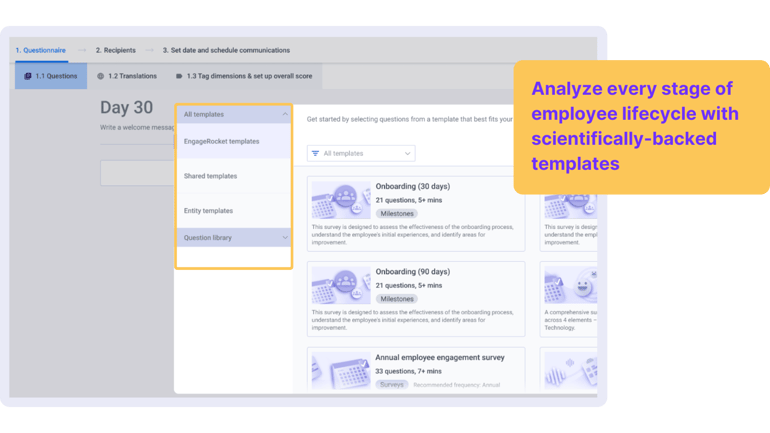 Science-backed templates library for all types of employee listening surveys ©EngageRocket
Science-backed templates library for all types of employee listening surveys ©EngageRocket
B. Exit survey
These surveys provide a confidential outlet for departing employees to express concerns openly. Exit surveys equip you with valuable insights about employee experiences and organizational dynamics.
C. Candidate experience survey
Typically conducted during or after the applicant's recruiting process, these surveys gauge the applicants' overall perceptions of the recruitment process. HR leaders can clearly understand what’s working in their hiring process and what could be improved.
D. 360 reviews survey
As the name suggests, a 360-degree survey gathers feedback from peers, managers, and direct reports about an employee's performance and behaviors.
D. Performance review survey
These surveys evaluate employees' work performance over a specific period. A performance review survey is an essential tool for measuring employee performance, setting goals, and identifying areas for improvement.
💡 Expert Tip:
Prevent survey fatigue by carefully managing the volume and content of survey requests. Recognize indications of survey fatigue by monitoring participation rates.
How often should you conduct employee listening surveys?
The ideal listening survey cadence varies from organization to organization and the goals they are trying to achieve. What are you trying to measure and learn about your organization? What is it you want to improve?
There is no golden rule. You just have to figure out what works for you and go with it.
Try to manage this tricky balance because if you don’t send enough surveys, you’ll miss opportunities to uncover critical insights and trends and act quickly. However, if you send too many surveys, your employees may feel disengaged and fatigued by many requests.
The best way is to supplement an annual employee engagement survey with pulse and lifecycle surveys to assess the success of your HR initiatives. You can increase their survey frequency by leveraging monthly, weekly, and “always-on” surveys for more actionable and fresh results. For instance, several companies like Cisco and GE have regular, real-time check-ins. Many keep an ongoing dialogue that may not even need to be structured and formal.
While setting up your survey cadence, the only thing to remember is to ensure you get enough information to drive the change you want to see within your organization. Additionally, you should take action based on your findings to boost employee engagement and growth.
Employee listening strategy examples to learn from
1. Shopback (Lifecycle Pulse Survey)
ShopBack, a popular online and offline rewards program in Southeast Asia, is an excellent example of a company that uses employee listening to achieve significant results. ShopBack noticed that employees who had been with them for 1-2 years had lower engagement scores. Its major challenge was re-engaging these employees and taking proactive measures to prevent further damage.
To address this issue, ShopBack used lifecycle pulse surveys facilitated by EngageRocket to continuously listen to its employees' feedback and improve employee engagement. They monitored quarterly employee engagement through pulse surveys, including eNPS (employee net promoter score). Continuous listening allowed them to identify areas of disengagement and opportunities for improvement quickly.
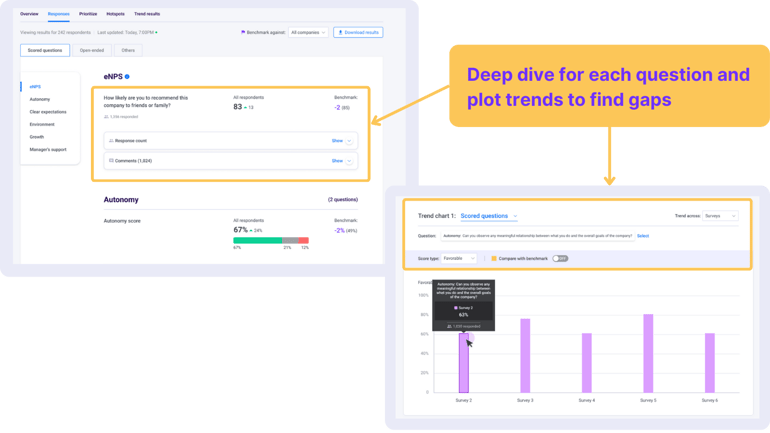
It's important to take the pulse deep dive ©EngageRocket
With complete visibility, ShopBack implemented employee-centric initiatives to engage employees. These initiatives included monthly shout-outs for outstanding contributions, quarterly awards ceremonies to acknowledge employees who embody company values, and a "Take a Break" benefit to promote work-life balance.
ShopBack's utilization of lifecycle pulse surveys facilitated by EngageRocket enhanced employee engagement and enabled the company to address emerging issues and swiftly improve its workplace culture.
2. M-DAQ (360 Reviews Survey)
M-DAQ is a Singapore-headquartered company that facilitates cross-border transactions with its FX solutions. As a fast-growing fintech company operating in a competitive industry, M-DAQ needs to address its workforce's evolving needs and expectations. This included attracting and retaining top talent amidst stiff competition and ensuring employees remained engaged and motivated.
M-DAQ utilized EngageRocket’s GROW platform for running 360-degree surveys to understand employee learning needs and foster growth within the organization. The platform offers easy-to-read data visualization features, such as Spider charts and Johari windows that are customized for each employee.

GROW 360 review feedback and peer evaluation platform ©EngageRocket
This allows the team to gain insights from multiple perspectives, including feedback from peers, supervisors, and self-assessments. The holistic view from these surveys enabled the M-DAQ team to identify strengths and areas for improvement for each employee, facilitating targeted development strategies. M-DAQ also developed a talent development framework focused on crafting culturally appropriate, scalable, and sustainable initiatives to foster individual and organizational growth.
Through its commitment to employee listening, M-DAQ has strengthened collaboration, enhanced contributions, and improved retention among its diverse workforce.
3. InCorp (Annual Engagement Survey)
InCorp Global, a leading provider of corporate solutions and business advisory services, aimed to unify its group of companies with an employee-first approach. Recognizing the importance of fostering a strong culture of engagement and providing a meaningful employee experience, InCorp Global sought to address the challenges of incorporating employee feedback for its thousand-strong workforce across eight different countries.
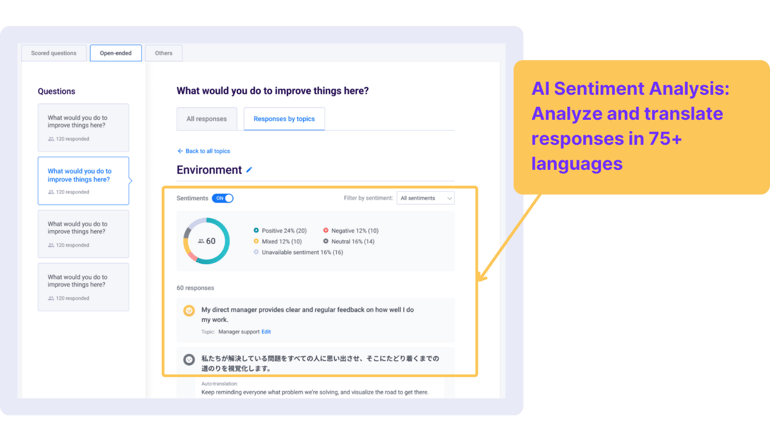
Enterprise ready: More than 75+ languages supported for international workforce ©EngageRocket
InCorp Global implemented EngageRocket's BELONG platform to measure and consistently improve employee engagement across its operating companies to achieve this goal. This unified approach allowed InCorp Global to streamline its feedback collection process and gain valuable insights into employee engagement levels across various segments, including departments, cohorts, managers, and countries.
"Employee engagement goes beyond compensation, salary, or benefits. It means equipping people with what they need to thrive and be their best selves. Our vision of unifying the group means we need to shift our approach and become more people-centric so our people can grow further along with the business."
— Edmund Lee, Group Chief Executive Officer of InCorp Global
By automating the feedback collection routine and conducting annual engagement surveys, InCorp Global could track engagement results regularly and identify areas for improvement. The BELONG platform's comprehensive dashboard and features, such as custom reports and segment comparison, enabled the organization to analyze survey results and spot high-risk groups or areas requiring further action.
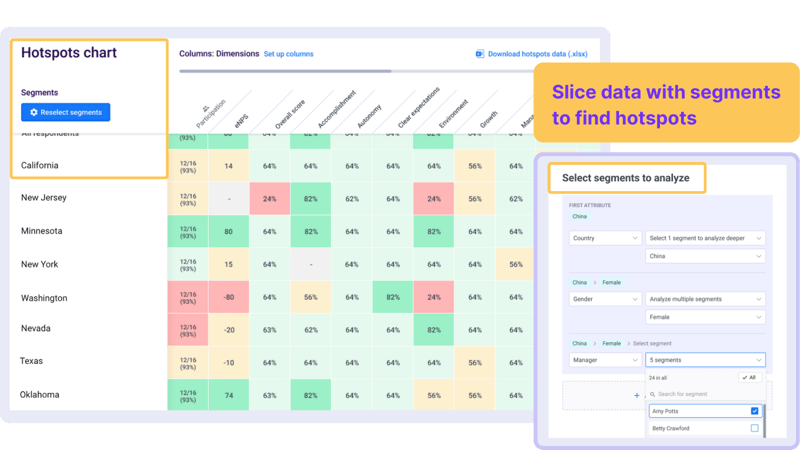
BELONG Hotspot chart and segment comparisons allow you to easily identify internal trends and areas of opportunity with the ability to slice & dice and co-relate multiple questions and attributes ©EngageRocket
Through active listening and acting upon feedback, InCorp Global demonstrated its commitment to putting employees at the heart of its business and creating a workplace where employees thrive and contribute their best.
Tips to make your employee listening survey strategy a success
Serving surveys and gathering data is just one fold of a concrete employee listening survey strategy. You must also dive deep into the data to drive meaningful organizational change. The above different surveys offer unique value on their own. However, you need to connect the dots to create a more comprehensive and actionable employee listening roadmap.
1. Identify the challenges
“What” are the underlying issues your employee listening survey seeks to answer? For instance, you might seek to understand the factors contributing to high turnover rates, low employee engagement scores, or team communication breakdowns. Or you might want to improve your hiring process. A focused goal in mind can help you analyze your survey results better.
2. Communicate clearly
Transparent communication is a vital part of a successful employee engagement strategy. Ensure managers and employees are kept in the loop at each stage—before, during, and after the survey.
3. Choose the right employee listening survey partner
Leveraging multi-channel listening and AI-powered insights and analytics is crucial as the business grows and expands. The right employee listening survey partner can bring their expertise to the table. It can provide the necessary tools and extract valuable insights from the results. This enables you to understand what actually matters most to your employees.
4. Collect and analyze the data
Each type of survey discussed above provides unique insight and value. Consolidating the results from each of them can help you with an in-depth understanding of your employees’ perceptions and experiences.
5. Act on the feedback
It's essential to take action on the feedback received to get the desired results from a survey. This involves creating an action plan and following up on it. The action plan should ensure everyone is on the same page and is accountable for their part in the process (including leadership and employees).
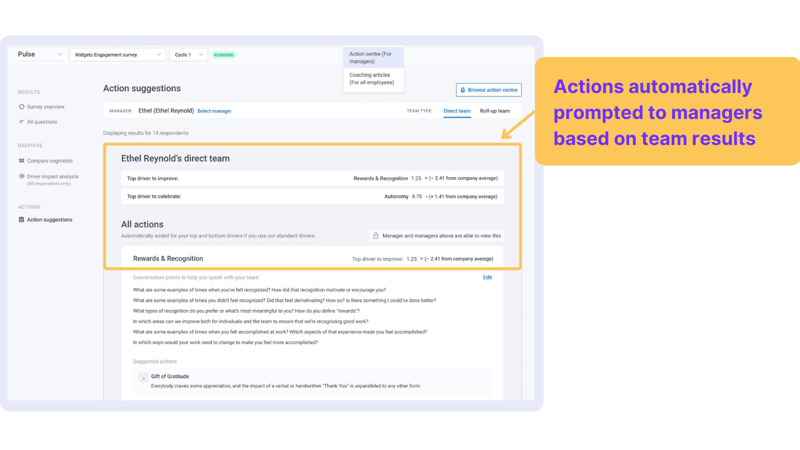
Empower all managers with curated action suggestions to create impactful sustainable action plans ©EngageRocket
6. Keep measuring the results
Employee listening is not a one-time thing. It's an iterative process wherein you should keep monitoring those actions with employee listening to ensure that what you put in place as the result of feedback has improved.
Creating and executing your employee listening strategy
Just like a data-led strategy is foundational for any business wanting to scale, a data-led employee listening strategy is crucial for fostering employee engagement, a positive workplace culture, and organizational success.
Build your listening campaigns strategically by starting with the annual engagement survey as the anchor. Since engagement surveys broadly cover diverse themes, you can integrate pulse surveys into your campaigns. You can also collect valuable insights by seeking feedback on individual leaders through a 360-degree feedback assessment.
Always remember, the cornerstone of any successful strategy is PEOPLE. Without a focus on people, even the most well-crafted plans and strategies may falter. Listen to them, prioritize their needs, and nurture a people-first culture.
Creating and implementing your employee listening strategy involves a fair bit of work. But EngageRocket can help you listen to the sentiment of the workforce and weave continuous listening into your culture:
- Quickly set up surveys with a scientifically validated question library
- Collect feedback with confidentiality
- Get high participation rates through multi-device surveys
- Analyze results and gain actionable insights instantly
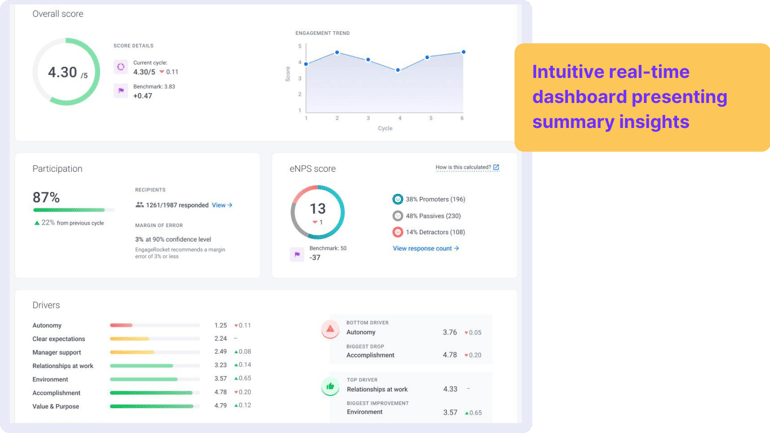 Improve engagement and retention at all stages with real-time dashboards ©EngageRocket
Improve engagement and retention at all stages with real-time dashboards ©EngageRocket
Want to know how EngageRocket can help you run employee listening surveys that generate results? Book a demo today!
FAQs
1. What is the value of employee listening?
Allowing your employees to have an active voice is important. Employee listening helps you understand their concerns, challenges, and apprehensions. It can surface different points of view and new ideas that contribute to better business results. Additionally, when employees feel comfortable voicing their opinions, it increases engagement and satisfaction.


.png?width=770&height=289&name=CTA-Banner-Blog%20(1201%20%C3%97%20450px).png)

 .
. 